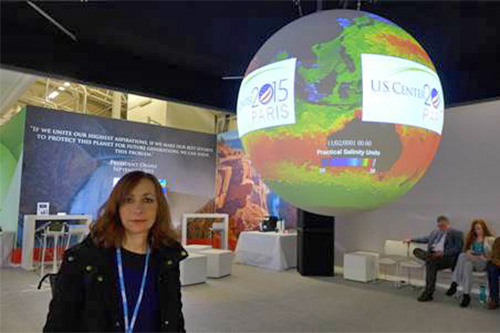Humanists offer critical perspective on climate change
By Linda B. Glaser

Climate change and other 21st-century environmental dangers put us all at risk, and technology alone does not hold the answers. Humanists at Cornell offer a critical perspective in the search for solutions.
Francis DiSalvo, director of the Atkinson Center for a Sustainable Future, notes “technological solutions, while necessary, are not sufficient. The cultural, social, historical, political and behavioral aspects of being human will determine what, how and if we will create a sustainable path for our planet and species.”
Adds Karen Pinkus, professor of Romance studies and comparative literature, “while big data studies and computer modeling can tell us something quantitatively, they don’t really give us a sense of what we might be facing as humans.” Pinkus was one of four Cornell professors selected to attend the December 2015 Paris COP21 climate-change negotiations.
Simply producing good science isn’t enough to make an impact without the right stories being told, Anindita Banerjee, associate professor of comparative literature, points out. People need to be able to imagine themselves living in that story and that future – and how people identify with a story can have a great impact on the future of political action, policy, and even research and development.
“The energy industry got the importance of telling stories a lot earlier than the environmental movement,” Banerjee says. “‘Scenarios’ are a very active part of how energy corporations have been managing their presence in public life.”
Environmental historian Aaron Sachs, associate professor of history, says as we struggle with the overwhelming nature of 21st-century problems, it’s important to remember the power of retrospection: “While no one can predict the future, the past offers lessons, not just from its calamities but from previous good ideas – like incorporating green space into our everyday habitations.”
Other lessons can be drawn from learning how the Earth’s climate has changed through history. The classical world and the greater old world offer a rich history over several thousand years and a detailed archaeological record back ever further, says Sturt Manning, the Goldwin Smith Professor of Classical Archaeology and chair of classics, who teaches Climate, Archaeology and History. That class brings together students from humanities and sciences, engaging them in a common – and critical – dialogue.
“By studying in detail the relationships between human societies and climate over time, we can begin to understand the impact climate change can have and we can see how humans succeeded or failed to adapt,” says Manning. “Climate and classics are good partners and relevant ones for the current and future world.”
Cornell has a universitywide climate change minor, thanks to a team that included Pinkus and faculty from three colleges and five departments. (Establishing a universitywide environment and sustainability major is currently being explored.) Some of the minor’s required core courses examine the human relationship to climate change, such as Ethics and the Environment, taught by historian Sara Pritchard, associate professor of science and technology studies. The class explores some of the challenging moral issues arising in the context of environmental management and policymaking.
Sachs, who is working on a history of environmental justice and an examination of why our culture ignores obvious environmental problems, notes a big focus in environmental studies is environmental justice and exposing environmental injustice built into our system of resource use, such as communities that tend to get “dumped on” in environmental terms. “If there weren’t vulnerable communities to put our toxic waste in, maybe we would find a way to not make as much toxic waste,” he says.
Art can offer crucial perspectives and even interventions related to environmental justice, as An-yi Pan, associate professor of history of art and visual studies, demonstrated in the exhibit he curated at the 2013 Venice Biennale. With the goal of raising awareness about the effects of climate change, his exhibit focused on the Polynesian island nation of Tuvalu, which is expected to be the first victim of a rising ocean level caused by global warming. Pan notes artists throughout history have used their work to express their concerns about social and environmental problems.
Linda B. Glaser is a staff writer for the College of Arts and Sciences.
Media Contact
Get Cornell news delivered right to your inbox.
Subscribe